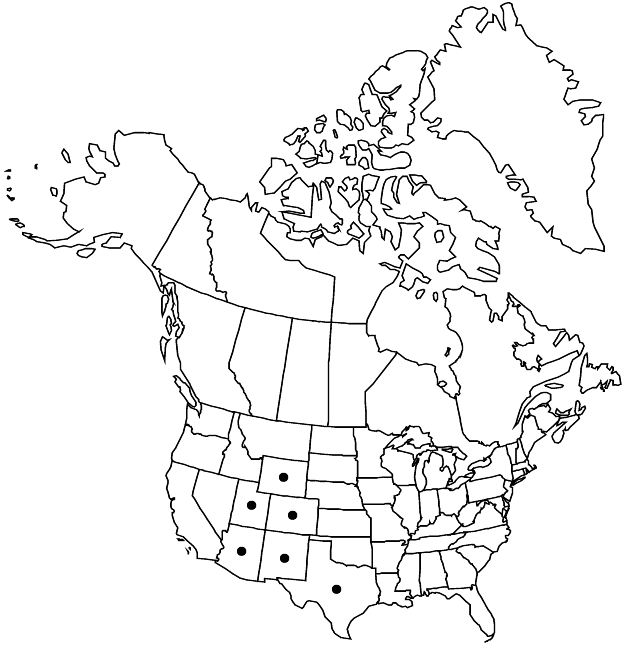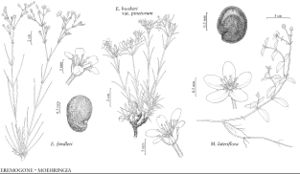Difference between revisions of "Eremogone fendleri"
Novosti Syst. Vyssh. Rast. 10: 139. 1973.
FNA>Volume Importer |
FNA>Volume Importer |
||
| Line 15: | Line 15: | ||
|name=Arenaria fendleri subsp. brevifolia | |name=Arenaria fendleri subsp. brevifolia | ||
|authority=Maguire | |authority=Maguire | ||
| − | }}{{Treatment/ID/Synonym | + | }} {{Treatment/ID/Synonym |
|name=Arenaria fendleri var. brevifolia | |name=Arenaria fendleri var. brevifolia | ||
|authority=(Maguire) Maguire | |authority=(Maguire) Maguire | ||
| − | }}{{Treatment/ID/Synonym | + | }} {{Treatment/ID/Synonym |
|name=Arenaria fendleri var. diffusa | |name=Arenaria fendleri var. diffusa | ||
|authority=Porter & Coulter | |authority=Porter & Coulter | ||
| − | }}{{Treatment/ID/Synonym | + | }} {{Treatment/ID/Synonym |
|name=Arenaria fendleri var. porteri | |name=Arenaria fendleri var. porteri | ||
|authority=Rydberg | |authority=Rydberg | ||
| − | }}{{Treatment/ID/Synonym | + | }} {{Treatment/ID/Synonym |
|name=Arenaria fendleri var. tweedyi | |name=Arenaria fendleri var. tweedyi | ||
|authority=(Rydberg) Maguire | |authority=(Rydberg) Maguire | ||
| − | }}{{Treatment/ID/Synonym | + | }} {{Treatment/ID/Synonym |
|name=Arenaria tweedyi | |name=Arenaria tweedyi | ||
|authority=unknown | |authority=unknown | ||
| Line 45: | Line 45: | ||
|elevation=1200-4300 m | |elevation=1200-4300 m | ||
|distribution=Ariz.;Colo.;N.Mex.;Tex.;Utah;Wyo. | |distribution=Ariz.;Colo.;N.Mex.;Tex.;Utah;Wyo. | ||
| − | |discussion=<p>We agree with M. F. Baad (1969) in not formally recognizing varieties within Eremogone fendleri. B. Maguire (1947, 1951) recognized five varieties, defined chiefly on leaf and sepal characteristics. While some specimens can be “matched” to varieties, many appear intermediate between them, forming a continuum of variation.</p><!-- | + | |discussion=<p>We agree with M. F. Baad (1969) in not formally recognizing varieties within <i>Eremogone fendleri</i>. B. Maguire (1947, 1951) recognized five varieties, defined chiefly on leaf and sepal characteristics. While some specimens can be “matched” to varieties, many appear intermediate between them, forming a continuum of variation.</p><!-- |
| − | --><p>B. Maguire (1947) noted that Eremogone fendleri is “probably to be found in the states of Sonora and Chihuahua, Mexico”; we have not seen any collections from that area.</p> | + | --><p>B. Maguire (1947) noted that <i>Eremogone fendleri</i> is “probably to be found in the states of Sonora and Chihuahua, Mexico”; we have not seen any collections from that area.</p> |
|tables= | |tables= | ||
|references= | |references= | ||
| Line 70: | Line 70: | ||
|publication year=1973 | |publication year=1973 | ||
|special status= | |special status= | ||
| − | |source xml=https://jpend@bitbucket.org/aafc-mbb/fna-data-curation.git/src/ | + | |source xml=https://jpend@bitbucket.org/aafc-mbb/fna-data-curation.git/src/8f726806613d60c220dc4493de13607dd3150896/coarse_grained_fna_xml/V5/V5_133.xml |
|subfamily=Caryophyllaceae subfam. Alsinoideae | |subfamily=Caryophyllaceae subfam. Alsinoideae | ||
|genus=Eremogone | |genus=Eremogone | ||
Revision as of 17:37, 18 September 2019
Plants ± cespitose, bluish green, not glaucous, with woody base. Stems erect, (2–)10–30(–40) cm, stipitate-glandular. Leaves: basal leaves persistent; cauline leaves in (4–)5+ pairs, reduced or not; basal blades ascending or recurved, filiform, 1–10(–11) cm × 0.2–0.4 mm, flexuous, herbaceous, apex apiculate to spinose, glabrous to puberulent, not glaucous. Inflorescences (1–)3–35-flowered, ± open cymes. Pedicels 3–25 mm, stipitate-glandular. Flowers: sepals weakly to prominently 1–3-veined, linear-lanceolate, 4–7.5 mm, not enlarging in fruit, margins broad, apex acuminate, moderately to densely stipitate-glandular on herbaceous portion; petals white, oblong-elliptic to spatulate, 4–8 mm, 0.9–1.3 times as long as sepals, apex entire to somewhat erose; nectaries as lateral and abaxial rounding of base of filaments opposite sepals, 0.2 × 0.4 mm. Capsules 5–7 mm, glabrous. Seeds black, ovoid to pyriform with hilar notch, 1.5–1.9 mm, tuberculate; tubercles rounded, elongate to rounded-conic. 2n = 44.
Phenology: Flowering spring–late summer.
Habitat: Sagebrush plains, pine forests, and mountain slopes to alpine zones
Elevation: 1200-4300 m
Distribution

Ariz., Colo., N.Mex., Tex., Utah, Wyo.
Discussion
We agree with M. F. Baad (1969) in not formally recognizing varieties within Eremogone fendleri. B. Maguire (1947, 1951) recognized five varieties, defined chiefly on leaf and sepal characteristics. While some specimens can be “matched” to varieties, many appear intermediate between them, forming a continuum of variation.
B. Maguire (1947) noted that Eremogone fendleri is “probably to be found in the states of Sonora and Chihuahua, Mexico”; we have not seen any collections from that area.
Selected References
None.
